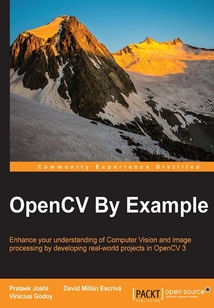目錄(95章)
倒序
- 封面
- 版權(quán)頁(yè)
- Credits
- About the Authors
- About the Reviewers
- www.PacktPub.com
- Support files eBooks discount offers and more
- Preface
- What this book covers
- What you need for this book
- Who this book is for
- Conventions
- Reader feedback
- Customer support
- Chapter 1. Getting Started with OpenCV
- Understanding the human visual system
- How do humans understand image content?
- What can you do with OpenCV?
- Installing OpenCV
- Summary
- Chapter 2. An Introduction to the Basics of OpenCV
- Basic CMake configuration files
- Creating a library
- Managing dependencies
- Making the script more complex
- Images and matrices
- Reading/writing images
- Reading videos and cameras
- Other basic object types
- Basic matrix operations
- Basic data persistence and storage
- Summary
- Chapter 3. Learning the Graphical User Interface and Basic Filtering
- Introducing the OpenCV user interface
- A basic graphical user interface with OpenCV
- The graphical user interface with QT
- Adding slider and mouse events to our interfaces
- Adding buttons to a user interface
- OpenGL support
- Summary
- Chapter 4. Delving into Histograms and Filters
- Generating a CMake script file
- Creating the Graphical User Interface
- Drawing a histogram
- Image color equalization
- Lomography effect
- The cartoonize effect
- Summary
- Chapter 5. Automated Optical Inspection Object Segmentation and Detection
- Isolating objects in a scene
- Creating an application for AOI
- Preprocessing the input image
- Segmenting our input image
- Summary
- Chapter 6. Learning Object Classification
- Introducing machine learning concepts
- Computer Vision and the machine learning workflow
- Automatic object inspection classification example
- Feature extraction
- Summary
- Chapter 7. Detecting Face Parts and Overlaying Masks
- Understanding Haar cascades
- What are integral images?
- Overlaying a facemask in a live video
- Get your sunglasses on
- Tracking your nose mouth and ears
- Summary
- Chapter 8. Video Surveillance Background Modeling and Morphological Operations
- Understanding background subtraction
- Naive background subtraction
- Frame differencing
- The Mixture of Gaussians approach
- Morphological image processing
- Slimming the shapes
- Thickening the shapes
- Other morphological operators
- Summary
- Chapter 9. Learning Object Tracking
- Tracking objects of a specific color
- Building an interactive object tracker
- Detecting points using the Harris corner detector
- Shi-Tomasi Corner Detector
- Feature-based tracking
- Summary
- Chapter 10. Developing Segmentation Algorithms for Text Recognition
- Introducing optical character recognition
- The preprocessing step
- Installing Tesseract OCR on your operating system
- Using Tesseract OCR library
- Summary
- Chapter 11. Text Recognition with Tesseract
- How the text API works
- Using the text API
- Summary
- Index 更新時(shí)間:2021-07-23 14:42:23
推薦閱讀
- The Supervised Learning Workshop
- Visual C++程序設(shè)計(jì)教程
- Spring Cloud Alibaba微服務(wù)架構(gòu)設(shè)計(jì)與開發(fā)實(shí)戰(zhàn)
- Android開發(fā)精要
- Getting Started with PowerShell
- PostgreSQL Replication(Second Edition)
- Getting Started with Gulp
- 區(qū)塊鏈底層設(shè)計(jì)Java實(shí)戰(zhàn)
- Learning Concurrency in Kotlin
- Swift 4 Protocol-Oriented Programming(Third Edition)
- Visual Basic程序設(shè)計(jì)習(xí)題與上機(jī)實(shí)踐
- H5+移動(dòng)營(yíng)銷設(shè)計(jì)寶典
- Akka入門與實(shí)踐
- R語言實(shí)戰(zhàn)(第2版)
- PHP動(dòng)態(tài)網(wǎng)站開發(fā)實(shí)踐教程
- Swift 2 Blueprints
- Selenium自動(dòng)化測(cè)試實(shí)戰(zhàn):基于Python
- Prezi Cookbook
- 破繭成蝶:用戶體驗(yàn)設(shè)計(jì)師的成長(zhǎng)之路
- Android系統(tǒng)應(yīng)用開發(fā)實(shí)戰(zhàn)詳解
- 計(jì)算機(jī)文化基礎(chǔ)
- GameSalad Essentials
- HTML5技術(shù)與移動(dòng)出版
- 鮮活的數(shù)據(jù):數(shù)據(jù)可視化指南
- Getting Started with Twitter Flight
- Oracle 12c數(shù)據(jù)庫(kù)應(yīng)用與開發(fā)
- C++程序設(shè)計(jì)與案例分析
- Python高并發(fā)與高性能編程:原理與實(shí)踐
- GraphQL實(shí)戰(zhàn):寫給全棧工程師們
- Android開發(fā)入門百戰(zhàn)經(jīng)典 (程序員典藏)


